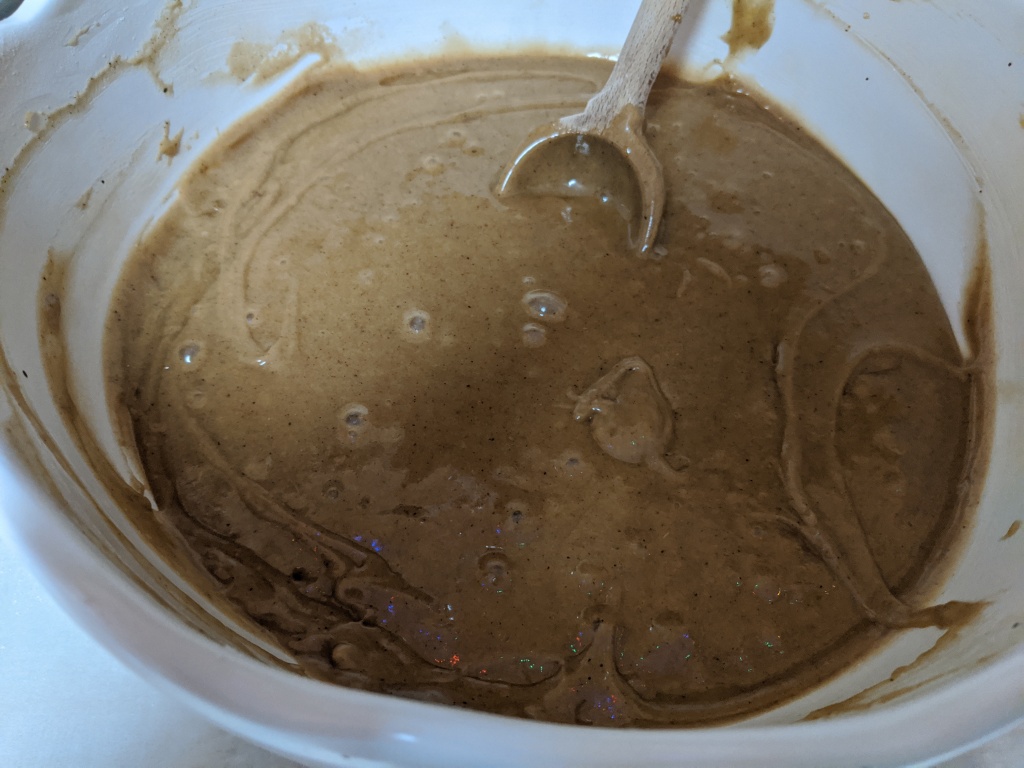Several years ago, my husband and I started a tradition of opening one or two gifts on Christmas Eve. One gift that I happened to open this year was a beautiful new cookbook, entitled Dinner with Dickens: Recipes Inspired by the Life and Work of Charles Dickens by Pen Vogler (thank you, Grandma!). As someone who loves reading Dickens’s books and watching adaptations of his stories, I was quite delighted by this gift! The cookbook includes beautiful pictures, excellent recipes with detailed instructions, and fascinating tidbits about Dickens and his books. If you take any pleasure from Dickens’s stories or from cooking classic British recipes, I would highly recommend this book!
Since I hadn’t planned much in advance for our Christmas dessert, I decided to try out a recipe for Gingerbread Cake from Dinner with Dickens. According to the book, gingerbread appears in Dickens’s David Copperfield, which just so happens to be my favorite of his novels. The kind, endearing character Mr. Dick is known for eating gingerbread, as described by the cookbook. Though Dickens did not illuminate his readers as to the particular kind of gingerbread Mr. Dick enjoyed, he did say:
“Mr. Dick was very partial to gingerbread. To render his visits the more agreeable, my aunt had instructed me to open a credit for him at a cake shop, which was hampered with the stipulation that he should not be served with more than one shilling’s-worth in the course of any one day.”
Charles Dickens, “Chapter 17. Somebody Turns Up,” in David Copperfield (Urbana, Illinois: Project Gutenberg, 2016), accessed December 30, 2020, David Copperfield, by Charles Dickens (gutenberg.org).
How much one shilling’s worth of gingerbread might be and what kind of gingerbread Mr. Dick ate are unknown to me, but I do know that the recipe from Dinner with Dickens was quite tasty! Since I hadn’t anticipated making this recipe, I lacked a few key ingredients but the cake turned out rather nicely all the same.
To make the cake, Vogler’s instructions first directed me to mix 4 eggs with 4 tablespoons of milk in one bowl, and about 3 and 1/2 cups of flour in another with a generous tablespoon of ground ginger and a teaspoon of ground cloves. Though the recipe didn’t call for any cinnamon or salt, I added about a teaspoon of cinnamon to the flour mixture and just 1/2 teaspoon of salt.

Then, the recipe instructed me to combine just under a cup each of molasses, corn syrup, and brown sugar with 3/4 cup of butter and some orange zest in a saucepan. At this point, I changed another thing: having no molasses in my pantry, but a surprising amount of honey, I substituted honey in for the molasses. The recipe directed that I should heat these sugars on the stove to melt the butter; since I’m really great at burning things, I made sure to stir constantly till the butter was melted. I then removed the mixture from the heat and let it cool slightly while I prepared my 8.5 x 8.5 pan. Next, I mixed the wet ingredients into the dry ingredients and, per the directions, stirred the batter quite thoroughly. I was surprised that the directions called for such intense mixing, as usually less stirring is better for cake batter, but I pushed on in hopes that the cake would turn out well.

I poured my batter into my 8.5 x 8.5 pan, which I’d buttered and lined with parchment paper on the bottom. Alas, this pan was just slightly too small, resulting in some rather amusing spillage over the edges during the baking process.

The recipe directed that the cake should bake at a low temperature for over an hour. This part I had to modify as well, since my husband was also cooking a pheasant for our Christmas supper, with which he did an amazing job! But, baking the cake in a slightly cooler oven (I used a temperature of about 300 degrees Fahrenheit) than what the recipe indicated didn’t seem to harm anything, thankfully. Checking for doneness towards the completion of the cake’s baking did result in a sunken middle, but the taste was none the worse for that.
When we finally sampled the cake later on Christmas day, I was quite pleased with the results! The cake is dense, but not dry or stodgy, as they’d say on the Great British Bake Off. The various changes I made – honey instead of molasses, the addition of cinnamon and salt, and even the baking mishaps – still produced a delightful flavor. Rather than frosting the cake, I topped it with a generous dollop of delicious lemon curd. As with many recipes that use a lot of spices, the cake was even better the next few days as the flavors got to know each other.

All in all, this cake made a delicious finish to our Christmas dinner and, at least for me, it added a Dickensian flair to our supper. If you’re hoping to find a light, airy gingerbread recipe, this is probably not the one for you. But, it is a cozy, tasty, comfort food type of cake, which I’m sure I’ll make again in the near future. I would highly recommend Dinner with Dickens and this recipe for all who love Dickens and classic, yummy dishes!
Notes
Penn Vogler, Dinner with Dickens: Recipes Inspired by the Life and Work of Charles Dickens (London: Cico Books, 2017), 92-93.
Charles Dickens, David Copperfield (Urbana, Illinois: Project Gutenberg, 2016), accessed December 30, 2020, David Copperfield, by Charles Dickens (gutenberg.org).
Images
Fred Barnard, “Mr. Dick with David Copperfield,” 1872 Household Edition, January 1, 1872, https://en.wikipedia.org/wiki/Mr._Dick#/media/File:Mr_Dick.png.

By the time you’re finished cooking all of these, you’re going to be ready to open your own bakery!
Keep posting girlie! 🙂
LikeLike